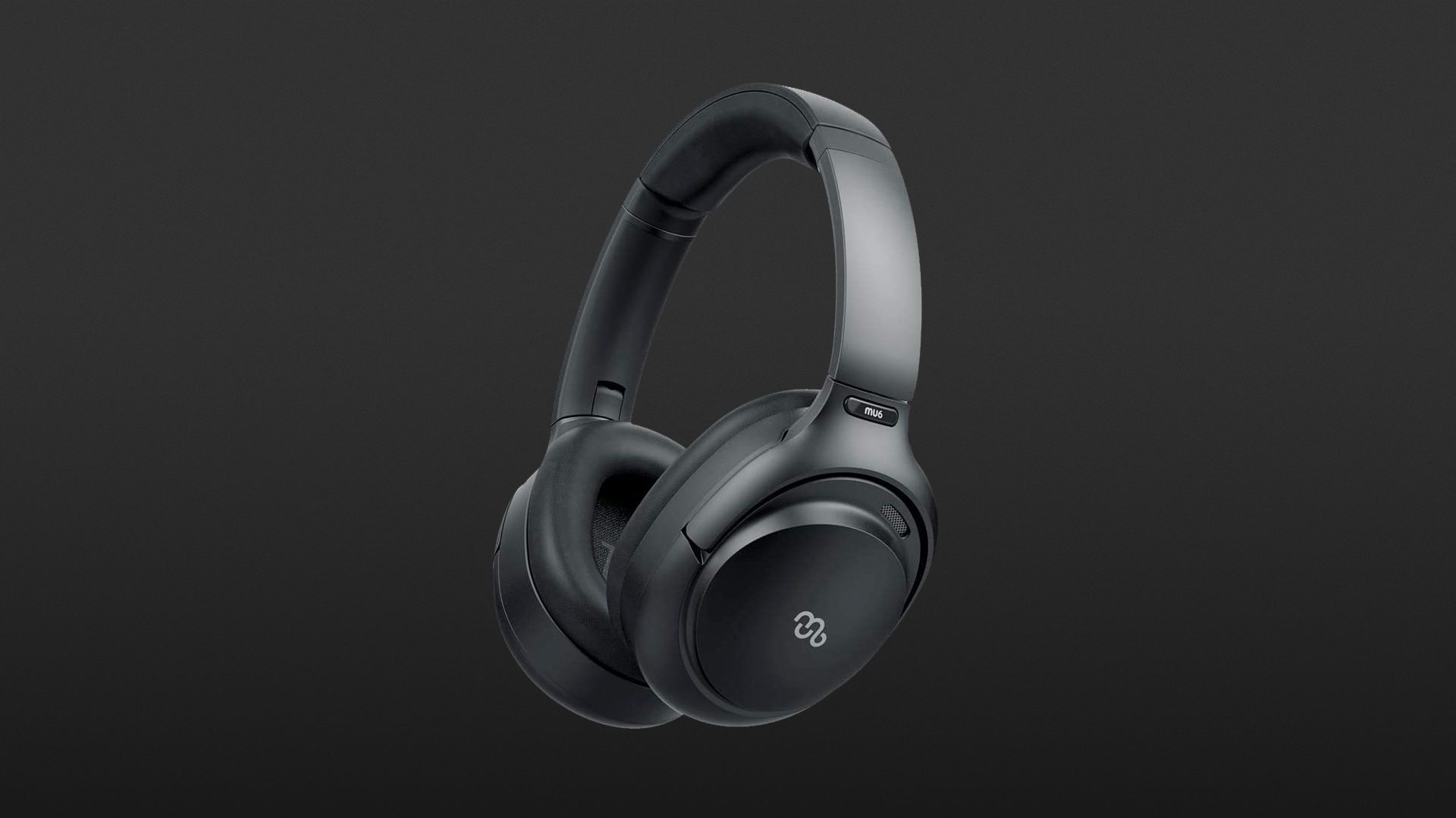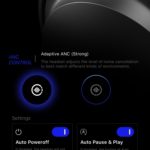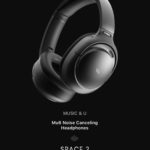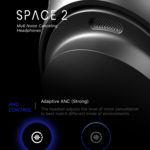Mu6 succeeds with the Space 2, a noise-cancelling headphone with good sound quality and good wearing comfort. The noise cancelling is also efficient, and I would award the test device with a good price-performance ratio, as long as you’re not too bothered by the rather clumsy touch functions. The noise-cancelling works quite well in practice but could be optimised in the future by extending control in what is a rather too simplistic app.
At 200 euros, the Space 2 saves you between 70 and 80 euros compared to the top models from the top names Sony, Sennheiser and Bose. The Space 2 is definitely worth its purchase price, but at the same time you can anticipate a little fine-tuning in the future due to the proximity to the aforementioned competitors.
Behind fledgeling headphone manufacturer Mu6 is a Chinese development team who, by their own account, have years of experience in noise cancelling. You’d be right to be curious, as their new Space 2 model, modern over-ear headphones with Bluetooth 5, offer impressive functionality at an attractive price. They have a clear aim: with these products, Mu6 seek to target a similar market to Sony, Bose and Sennheiser.
On the outside, the black Space 2 have a simple, contemporary and elegant appearance. The robust, adjustable construction, made mainly of plastic with rotating ear cups, is just as appealing as the padding, which is made of genuine leather. All in all, this results in a high level of wearing comfort that does not disturb the wearer, even over several hours. Their weight of 290 grams is not much higher than that of the competition.
Thanks to the ear cups that fold in on both sides, the Space 2 can be used with only one ear if required and can also be efficiently stowed away, ideally in the compact carrying case which is supplied.
The technical spec is pretty lavish, with Bluetooth 5, adaptive noise cancelling as well as codecs SBC, AAC aptX and aptX-LL, but aptX HD and LDAC would still have been on my wish list. As for the controls, the Mu6 are reliant on a combination of two multifunction buttons at the bottom of the left ear cup and the touch-sensitive outer side of the right ear cup. In addition, there is a status LED, voice announcements and optional cable operation.
In practice
The first button switches the device on and off, provides a battery level indicator and initiates pairing. The second button switches between the noise-cancelling modes and calls up the voice assistant in your smartphone. The touch-sensitive area on the right ear cup allows you to start and pause music by tapping, volume is controlled by swiping up and down, and you can jump through titles in a similar way (by swiping from left to right and vice versa). A short tap activates the so-called transparency function, where external noise is transmitted to the drivers via the built-in microphones, thus enabling improved perception of the environment and communication when headphones are in place. Finally, phones calls can also be handled by tapping the touch-sensitive area.
In practice, the Space 2 deserve criticism for these touch functions. They are comparatively unreliable, and I didn’t really enjoy using them. It was easy to accidentally trigger functions when putting on and taking off the headphones. I quickly caught myself reaching for my Smartphone instead. There are many competitors what can do this better. This also applies to the often needed function of temporarily switching on the transparency mode by placing the palm of your hand on the ear cup. In my opinion, the reaction to this gesture is simply too slow.
The automatic pause function is also unreliable. It does not always start when the headphones are removed from around the neck, but only when the headphones are actually taken off. The additional function which automatically switches off the headphones after five minutes did not work with my test device.
The Space 2 scores points with a Bluetooth wireless link that is quickly restored. In addition, it shines with a good working range, which means you can move around your home without interruption. Praise is also due for the runtime of the 800 mAh battery. The manufacturer advertises a full charge (after 4 hours charging time) of about 20 or 24 hours continuous operation (ANC on/off), depending on the playback volume. In fact, this runtime specification is pretty realistic and in any case, makes them best suited for long trips and continuous operation. And for intermediate top-ups, there is a quick charge function.
The free iOS/Android app “Mu6 Connect” is rather disappointing. Besides voice and reset functions, it offers the possibility to choose between two intensity levels for noise cancelling and to configure the two automatic functions (autopower, autoplay/pause). Firmware updates are possible according to the manual, but were not visible.
Noise Cancelling
With noise cancelling, the user can initially rely on good passive noise insulation. Adaptive Noise Cancelling relies on the proven method of cancelling external noise, which is captured by microphones and is integrated into the sound in reverse phase. As already mentioned, there is only a choice between two gradations and transparency mode (permanently activated by a switch). In fact, the Mu6 offers more than that, as the intensity of the noise reduction is also automatically adjusted to movement pattern and to the surrounding situation. In this way, the manufacturer aims to guarantee an optimal signal-to-noise ratio while maintaining the best possible sound quality.
In practice there are also some drawbacks. On the one hand, noise cancelling is accompanied by audible background noise, but this is only really disturbing when the headphones are in operation without music and in quiet environments. The noise-cancelling itself operates up to 1,000 Hz and, according to the manufacturer, reduces background noise by up to 40 decibels. My impression during a train ride was actually positive because noise and low frequencies were efficiently reduced, restoring a pleasant calm. However, the automatic adaptation to the ambient situation did not convince me. The results are either too subtle or can only be perceived in the form of a rather arbitrary shift. In fact, I would have been better off with an intensity control for the degree of lowering and would have been happier having the freedom to make individual adjustments. But a quite intense result remains with the background noise reduction.
Sound
The Space 2’s dynamic 40 mm drivers deliver a coherent and level-rich sound. Most of this sound evaluation was done with an iPhone 8 at the highest noise cancelling level. In my opinion, this has hardly any negative effect on the sound apart from the already noted background noise, but on the contrary, creates an extended “quiet room” and thus more focus on the music. Of course in your own living room at home, you can deactivate the system.
The basic sound is powerful rather than delicate and audiophile – these are headphones for daily mobile use with pop and rock. I had a lot of fun after hours of listening, even at low volumes. On the other hand, these headphones don’t get out of balance even at higher levels.
The bass range is powerful and a bit too voluminous, but still defined and well fanned out. Making this a tuning that is quite suitable for modern genres and mobile use. The central midrange is well represented and offers the necessary richness not only to acoustic instruments but also to electric rock guitars. Voices are also reproduced clearly, with good speech intelligibility and sufficient speed for consonants and other explosive sounds.
From the off, the Space 2 sound open, but not biting. This results in a clear reproduction of details and a cleanly projected stereo panorama. Due to the price range, I don’t want to mention the smooth shine in the high-frequency range.
The dynamic reproduction is also attractive. And finally, the reproduction of echo and room effects up to staggered depths is above average for closed headphones. In short: an extremely respectable result.
Cable operation is possible both passively and with active electronics and noise cancelling. The fact that the Space 2 operate with virtually identical sound quality when switched off speaks for their good basic construction. Last but not least, I would rate the voice quality of telephone calls as satisfactory to good.
Technical specifications
- Ear couplingOver-ear
- Typeclosed
- Transducer principledynamic
- Frequency response (headphones)20 - 20.000 Hz
- Impedance32 ohms
- Weight without cable290 g
What's in the box
- USB charging cable (USB A to USB C)
- Audio cable (2.5 to 3.5 mm)
- Transport case
Special features
- BT codecs: aptX, aptX LL, AAC, SBC
- BT version: 5.0












































